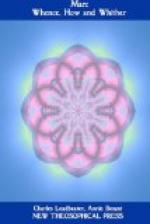Let us recapitulate. The schematic worm had a body composed of two concentric tubes. The outer was composed of the muscles of the body covered by the protective integument. The inner tube was the alimentary canal with its special muscles. Between these two was the perivisceral cavity, filled with nutritive fluid, lymph, and furnishing a safe lodging-place for the more delicate viscera. It represented fairly the trunk of higher animals.
The annelid added segmentation, and thus greater freedom of motion by the parapodia. But the segments were still practically alike. In the insect division of labor took place, that is, each group of segments was allotted its own special work; and these groups of segments were modified in structure to best suit the performance of this part of the work of the body. The abdomen was least modified and its eleven segments were devoted to digestion, reproduction, and excretion—the old vegetative functions. Three segments were united in the thorax; all their energy was turned to locomotion, and the insect became thus an exceedingly active, swift animal. The third body-region, the head, includes six segments, of which three surrounded the mouth and furnished the jaws, while two more were crowded or drawn forward in order that their ganglia might be added to the old supraoesophageal ganglion and form a brain. It is interesting to note that a form, peripatus, still exists which stands almost midway between annelids and insects and has only four segments in the head. The formation of the head was thus a gradual process, one segment being added after another.
In the turbellaria the dominant functions were digestion and reproduction, and their organs composed almost the whole body. Here only eleven segments at most are devoted to these functions, and nine in head and thorax to locomotion and brain. Head and thorax have increased steadily in importance, while the abdomen has decreased as steadily in number of segments. And the brain is increasing thus rapidly because there are now muscles and sense-organs of sufficient power to make such a brain of value. And this brain perceives not only objects and qualities, but invisible relations between these, and this is an advance amounting to a revolution. It remembers, and uses its recollections. It is capable of learning a little by experience and observation. The A, B, C of thinking was probably learned long before the insect’s time, and the bee shows a fair amount of intelligence.
The line of development which the insect followed was comparatively easy and its course probably rapid. Certain crustacea, aquatic arthropoda, are among the oldest fossils, and it is possible that insects lived on the land before the first fish swam in the sea. They had fine structure and powers; and yet during the later geologic periods they have scarcely advanced a step, and are now apparently at a standstill. They ran splendidly for a time, and then fell out of the race. What hindered and stopped them?




